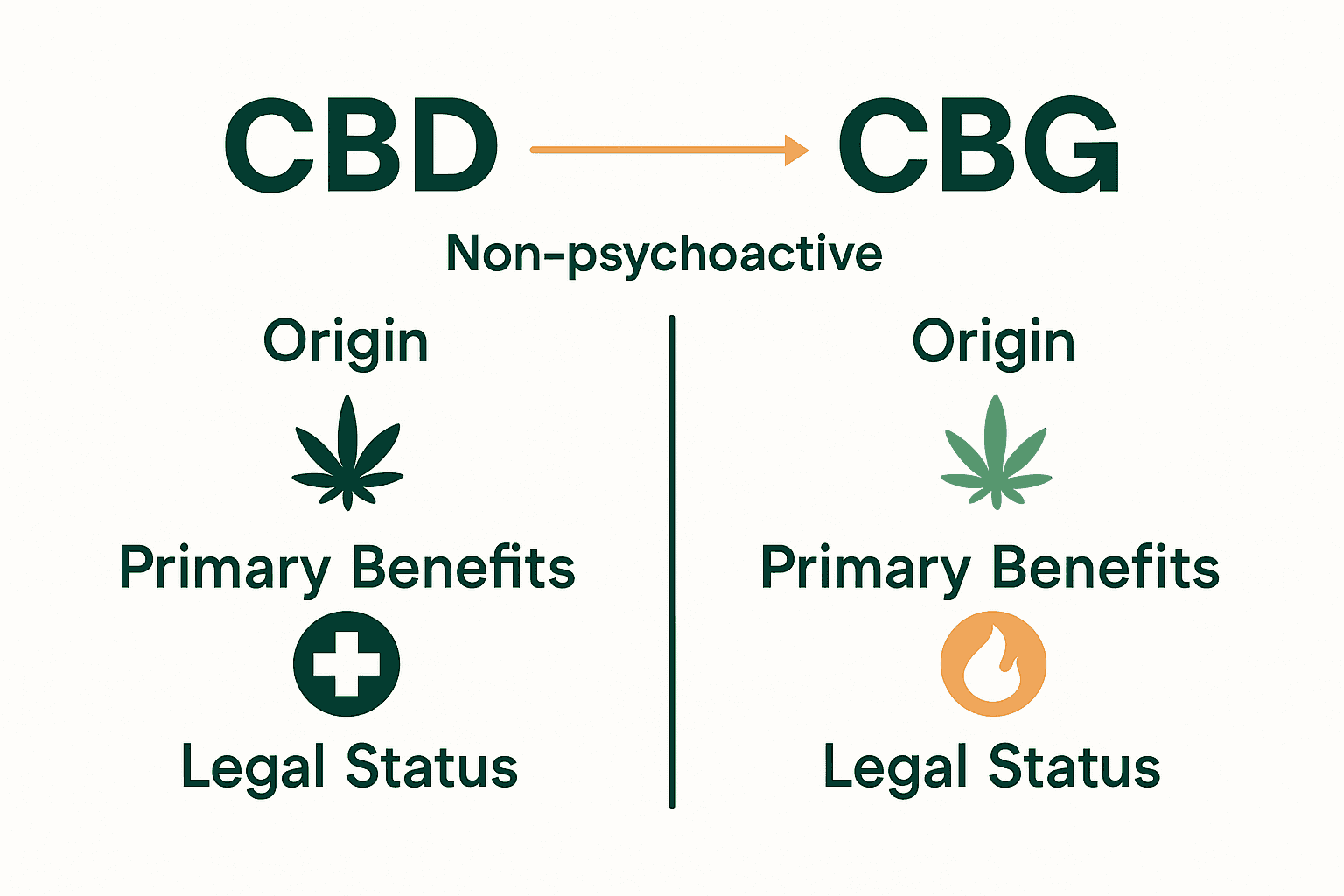Over 100 unique cannabinoids shape the profile of each cannabis plant, yet two stand out for their growing impact on wellness trends. With more people exploring CBD and CBG for their non-psychoactive effects and potential health benefits, understanding their differences matters now more than ever. This guide will clarify exactly what sets these cannabinoids apart, how they work in the body, and why their roles are catching the attention of both researchers and everyday users.
Table of Contents
- Defining CBD and CBG Cannabinoids
- Natural Origins and Extraction Methods
- Wellness Effects and Potential Benefits
- Comparing Side Effects and Safety Risks
- Legal Status of CBD and CBG Products
Key Takeaways
| Point | Details |
|---|---|
| CBD vs CBG | CBD is widely studied for its therapeutic effects, while CBG is emerging as a potentially beneficial cannabinoid, especially in pain and inflammation management. |
| Extraction Techniques | Common methods like CO2 and ethanol extraction are utilized for isolating cannabinoids, ensuring the preservation of their molecular integrity. |
| Safety Profile | Both CBD and CBG generally exhibit a good safety profile, with mild side effects like fatigue and digestive discomfort; however, users should consult healthcare providers. |
| Legal Status | The legal framework for cannabinoids varies widely by jurisdiction, emphasizing the need for ongoing awareness of federal and state regulations. |
Defining CBD and CBG Cannabinoids
Cannabinoids are complex chemical compounds found in cannabis plants that interact with our body’s endocannabinoid system. Two fascinating molecules that have captured significant scientific and wellness attention are cannabidiol (CBD) and cannabigerol (CBG). While they might seem similar at first glance, these cannabinoids have unique characteristics and potential benefits.
According to research from PubMed, cannabigerol (CBG) is a biologically active compound generated during the non-enzymatic decarboxylation of cannabigerolic acid, serving as a critical precursor to various other phytocannabinoids. This makes CBG particularly intriguing because it essentially acts as a “mother cannabinoid” from which many other compounds are derived.

Cannabidiol (CBD), as identified by DEA Diversion, is characterized by its low affinity for CB1 and CB2 receptors. Specifically, CBD functions as an antagonist at CB1 receptors and exhibits inverse agonistic properties at CB2 receptors. This unique interaction means CBD can potentially modulate various physiological processes without producing the psychoactive effects associated with THC.
Key differences between CBD and CBG include:
Here’s a comparison of CBD and CBG across key dimensions:
| Feature | CBD | CBG |
|---|---|---|
| Origin | Derived from CBG Found in higher concentrations |
Precursor cannabinoid “Mother of all cannabinoids” |
| Receptor Interaction | Antagonist at CB1 Inverse agonist at CB2 |
Interacts with CB1, CB2, and others |
| Typical Abundance | High in mature plants | Low in mature plants |
| Psychoactivity | Non-psychoactive | Non-psychoactive |
| Research Status | Extensively studied | Emerging research |
| Noted Benefits | Antioxidant Potential stress and pain relief Supports homeostasis |
Antioxidant May support pain, inflammation, and neuroprotection |
| Example Extraction Methods | CO2, Ethanol, Lipid, Steam Distillation | CO2, Ethanol, Lipid, Steam Distillation |
| Notable Side Effects | Mild fatigue Digestive discomfort Appetite changes |
Mild fatigue Digestive discomfort Appetite changes |
| Legal Status (US) | Varies by state Usually legal if THC < 0.3% |
Varies by state Usually legal if THC < 0.3% |
- Origin: CBG is a precursor cannabinoid, while CBD is a more refined compound
- Receptor Interaction: CBD acts as an antagonist, while CBG has different interaction mechanisms
- Concentration: CBG typically exists in lower quantities in mature cannabis plants compared to CBD
- Research Stage: CBD has been more extensively studied, whereas CBG research is still emerging

To explore more about these fascinating compounds, check out our comprehensive guide on cannabinoid differences.
Natural Origins and Extraction Methods
Understanding the natural origins of cannabinoids reveals a fascinating botanical journey through cannabis plant biochemistry. Phytocannabinoids like CBD and CBG emerge from complex molecular transformations within the cannabis plant, representing intricate natural chemical processes that have captivated scientific researchers and wellness enthusiasts alike.
According to research from AVMA, these cannabinoids originate from carboxylated forms such as cannabigerol (CBG) or cannabigerovaric acid (CBGVA). Interestingly, CBG rapidly metabolizes into other cannabinoids like THC, CBD, and CBC, which explains why mature cannabis plants typically contain low concentrations of CBG.
The extraction methods for these cannabinoids are equally nuanced. Manufacturers typically employ several techniques to isolate these compounds, including:
- CO2 Extraction: Uses pressurized carbon dioxide to pull cannabinoids from plant material
- Ethanol Extraction: Involves using high-grade alcohol to separate cannabinoids
- Lipid Extraction: Utilizes natural fats to extract and preserve cannabinoid compounds
- Steam Distillation: A gentler method that preserves delicate molecular structures
PubMed research highlights that CBG is a non-psychoactive cannabinoid interacting with multiple signaling pathways, including CB1, CB2, and other receptor systems. This complex interaction underscores the importance of precise extraction methods that maintain the compound’s delicate molecular integrity.
For those curious about diving deeper into hemp’s botanical world, explore our guide on hemp infusion to understand more about these fascinating plant-based compounds.
Wellness Effects and Potential Benefits
Cannabinoids like CBD and CBG have captured significant attention in wellness circles for their potential therapeutic properties. Wellness potential extends far beyond simple supplementation, representing a nuanced approach to supporting overall health and managing various physiological challenges.
According to PubMed research, CBG has emerged as a particularly promising therapeutic agent with potential applications in addressing complex health conditions. The research highlights CBG’s potential in alleviating challenges related to cancer, metabolic disorders, pain management, and inflammatory diseases through its interactions with the endocannabinoid system and key signaling pathways.
Complementing CBG’s profile, scientific investigations have demonstrated remarkable antioxidant capabilities of both CBD and CBG. These compounds exhibit impressive free radical scavenging abilities, which contribute to their potential therapeutic effects by:
- Preventing oxidation processes
- Reducing harmful metal ions
- Supporting cellular protection
- Potentially mitigating oxidative stress
Beyond antioxidant properties, these cannabinoids interact with our body’s complex systems in ways that suggest broader wellness implications. The intricate mechanisms of CBD and CBG make them fascinating subjects for ongoing research, promising potential benefits across multiple health domains.
For those interested in exploring how cannabinoids might support their wellness journey, check out our guide on CBG-infused drinks for wellness.
Comparing Side Effects and Safety Risks
Understanding the safety profile of cannabinoids like CBD and CBG is crucial for responsible consumption. Safety considerations go beyond simple wellness claims, requiring a nuanced examination of potential risks and individual physiological responses.
Research from PubMed provides encouraging insights into the safety of these compounds. Notably, CBD and CBG demonstrate an impressive safety profile, showing no evidence of cytotoxicity, mutagenicity, or skin sensitization. The studies reveal an absence of primary irritability, accumulated irritability, phototoxicity, and photosensitization - particularly promising for topical applications.
However, potential side effects and interactions warrant careful consideration. Key potential side effects include:
- Mild fatigue
- Changes in appetite
- Potential interactions with other medications
- Temporary digestive discomfort
Harvard Health highlights an important caution: while CBD has gained popularity for addressing conditions like chronic pain, insomnia, and anxiety, the rapid adoption potentially outpaces comprehensive scientific evidence. This underscores the importance of consulting healthcare professionals and approaching cannabinoid use with informed caution.
To learn more about navigating cannabinoid wellness, explore our guide on Delta-8 and its role in wellness.
Legal Status of CBD and CBG Products
Navigating the complex landscape of cannabinoid regulations requires careful understanding and ongoing awareness. Legal considerations for CBD and CBG products represent a nuanced and evolving legal framework that varies significantly across different jurisdictions and regulatory environments.
According to International Food Science & Technology, the legal status of cannabinoids remains complex and highly variable. Regulations differ dramatically across jurisdictions, with ongoing discussions about classification and permissible uses creating a dynamic regulatory environment.
Key legal considerations for CBD and CBG products include:
- Federal vs. State Level Regulations
- Source of Cannabinoid (Hemp vs. Marijuana)
- THC Concentration Limits
- Product Type and Intended Use
- Manufacturing and Testing Standards
Research from DEA Diversion highlights the complexity of cannabinoid classification, noting CBD’s unique molecular properties and its classification as a major cannabinoid with specific receptor interactions. These technical distinctions play a crucial role in determining legal status and regulatory approach.
For more insights into cannabinoid regulations and nuanced legal landscapes, explore our comprehensive guide on cannabinoid differences.
Discover the Power of CBD and CBG for Your Wellness Journey
Understanding the key differences between CBD and CBG can be overwhelming, especially when you want to find the right product that truly supports your wellness goals. Whether you are seeking antioxidant benefits, pain relief, or natural homeostasis support, knowing how these cannabinoids work will help you make confident choices without confusion or guesswork. If you have felt unsure about where to start or how to include these compounds in your daily routine, you are not alone.
Explore our premium collection of CBG products designed to deliver the potent, non-psychoactive benefits described in the latest research. Our carefully crafted selections offer quality you can trust combined with modern extraction methods to preserve natural properties.

Unlock the potential of cannabinoids with 23State. Visit 23state.com today and take advantage of exclusive offers that make integrating CBG and CBD into your lifestyle easier than ever. Start your journey now and feel the difference for yourself.
Frequently Asked Questions
What are the main differences between CBD and CBG?
CBD (cannabidiol) is derived from CBG and found in higher concentrations in mature cannabis plants, while CBG (cannabigerol) is a precursor cannabinoid and typically exists in lower amounts. CBD primarily acts as an antagonist at CB1 receptors and an inverse agonist at CB2 receptors, whereas CBG interacts with multiple receptor systems.
Are CBD and CBG psychoactive?
Both CBD and CBG are non-psychoactive cannabinoids, meaning they do not produce the intoxicating effects commonly associated with THC (tetrahydrocannabinol).
What are the potential health benefits of CBD and CBG?
Both cannabinoids offer antioxidant properties and may help with stress relief, pain management, inflammation, and support for overall wellness through their interactions with the endocannabinoid system.
How are CBD and CBG extracted from cannabis plants?
CBD and CBG can be extracted using various methods, including CO2 extraction, ethanol extraction, lipid extraction, and steam distillation, ensuring the preservation of their delicate molecular structures.

